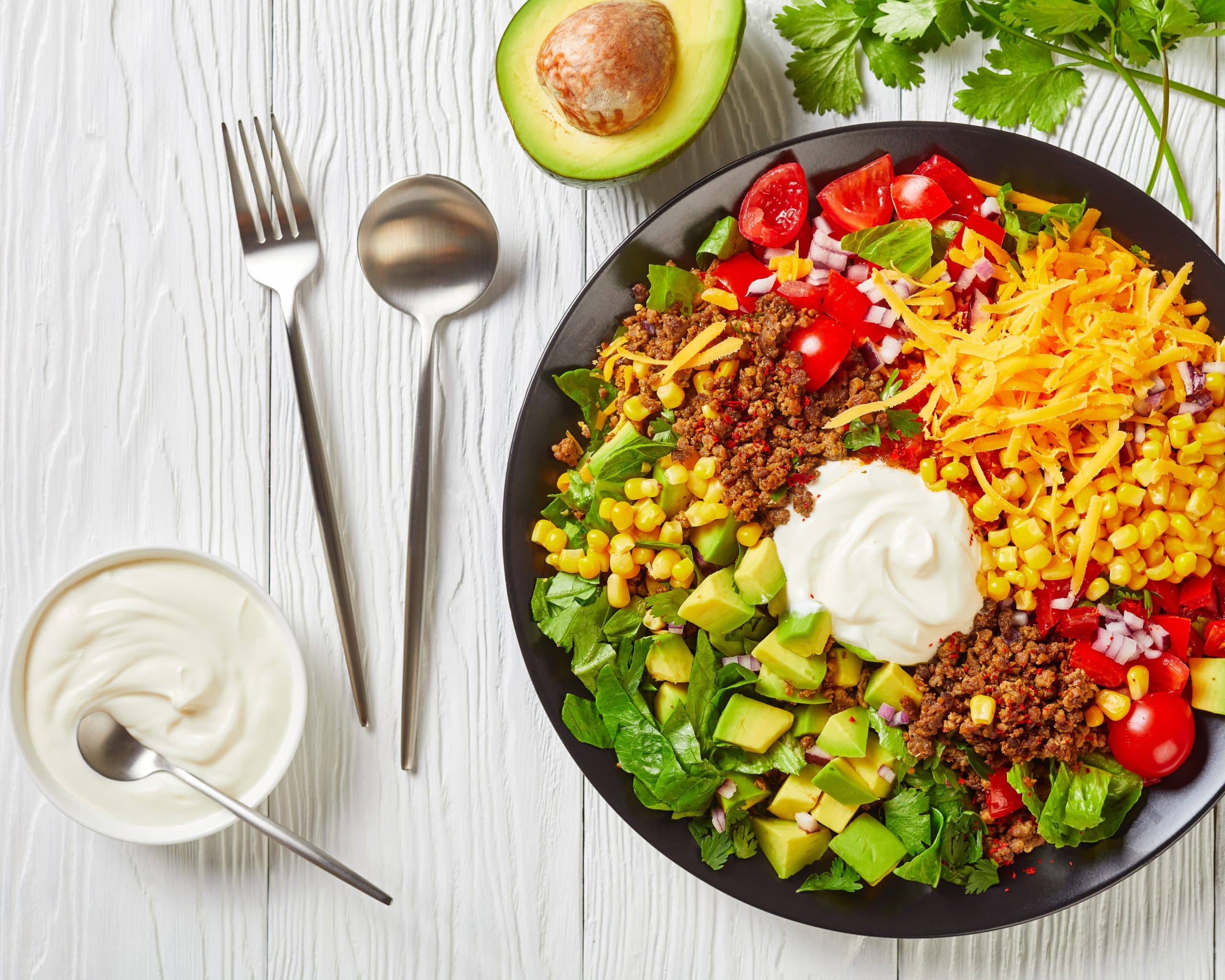So you are trying to lose, maintain, or gain weight. Getting into a calorie deficit, or surplus is what the experts say you should do. You constantly hear the term “macros”, and wonder what it is and why it matters. We know – learning about nutrition and weight often feels like walking through a minefield. To help you out, we will explain what are these 3 macronutrients.
There are two types of nutrients: macronutrients and micronutrients. Although both are important, the former is essential for bodily functions. The 3 macronutrients in food are essential and manipulating the amounts you consume of each is the key to weight loss/gain. Curious to know how? Read on to find out.
What Are The 3 Primary Macronutrients?
Macronutrients are needed by your body in larger amounts than micronutrients. Because they provide energy for your body to function, you cannot live without them. Not surprisingly, they are found in all foods that you eat daily. Macronutrients are carbohydrates, protein, and fat.
Giving you energy is not all they do. Each macronutrient has additional functions that we will discuss further along in the article. An important fact to keep in mind is that different people require different quantities of each (6).
Carbohydrates
If you know a thing or two about losing or maintaining weight, you know what a bad reputation carbohydrates can have sometimes. Keto, Paleo, and other diets shun most sources of carbs and emphasize protein consumption (3). Are these macros that bad? Before you write off carbs completely, you should know that they are your body’s main source of energy.
Carbs are broken down into glucose for energy provision. All your body organs need glucose – your brain is in particular need of it. Fuel derived from the breakdown of this macro is also necessary for intense exercise.
What is the recommended daily intake of carbohydrates? According to the Dietary Guidelines for Americans, carbs should comprise 45% – 65% of your daily calorie intake (2). Note that this macronutrient provides about 4 calories per gram.
Some carbs are healthier than others. It is why you should focus more on choosing the right type of carbohydrates rather than avoiding them altogether.
Read More: Mediterranean Diet Macros: Taking A Closer Look At What Eating Mediterranean-Style Actually Means
Simple Carbohydrates
These are made up of single glucose molecules and are easily broken down into glucose. Their simple structure makes them a quick source of energy. Sugary food items are examples of simple carbs. Sugar, honey, syrup, molasses, and fruit fall in this category.
Carbs get their bad reputation from processed foods that contain simple carbs and have a high glycemic index. White bread, rice, pasta, soda, pastries, and other refined foods usually have a high refined carbohydrate content. This can contribute to weight gain, diabetes, hormonal imbalance, and other health-related diseases.
You want to avoid simple carbs as much as possible, except for fruits. Although fruits are sugary, they have fiber, vitamins, antioxidants, and other nutrients that make them worth eating.
Complex Carbohydrates
These are made up of long, complex chains of sugar molecules. Your body needs more time to break down these molecules into glucose. Therefore, complex carbs are satiating.
Examples of foods that have this nutrient are whole grains such as wheat and rice, starchy vegetables such as potatoes and peas, beans, nuts, and seeds. They also contain fiber, which is important for digestion. Although fiber does not have any nutritional value, it stimulates the digestive tracts and enables waste elimination.
The Low Carb Diet
If you eat 2000 calories a day, 900-1300 should come from carbs – that is if you follow the Dietary Guidelines for Americans (2). However, many low-carb diets will have you eating much less of such foods. Most diets suggest a 25% – 30% intake which translates to 500 calories from carbs each day.
A low-carb diet fronts fat and protein as alternative energy sources. However, these other macronutrients are not as efficient at energy supply. Ketones, a by-product of using fat to produce energy are considered metabolic waste. Over time, they may harm one’s body. Protein, on the other hand, compromises muscle building to provide energy. So, carbs remain the best and main source of energy for the human body.
What should you do about carbs? Focus not only on quantity but also on quality. Ensure that your daily carb intake comprises mostly complex, unrefined carbs. Whole grains like brown rice and oats and starchy vegetables are great choices. Always read labels – choose 100% whole grain products.
Protein
Of the 3 different types of macronutrients, protein is most important to build muscle mass. As a result, it is quite popular in the fitness world. It is found in meat, eggs, and leguminous plants. What most people do not know is that protein does more than build muscles. It contains 20 amino acids that play a tremendous role within your organs, bones, it also regulates your metabolism, and maintains a neutral environment (4).
BetterMe will keep you laser-focused on your weight loss journey! Nutrient-packed meal plans, fat-blasting workouts, galvanizing challenges and much more. Try using the app and see for yourself!
Essential Amino Acids
Your body cannot produce some of the amino acids – so you must get them from your diet. They comprise 9 out of 20 amino acids. They are at the core of many vital processes including:
- Fat metabolism
- Immune function
- Nitrogen balance
- Mineral absorption
- Blood sugar regulation
- Wound healing
- Hemoglobin production
Non-Essential Amino Acids
Your body can produce them, so you do not need to consume them through diet. However, some sources of protein have them in abundance. Nonessential amino acids are equally important as they are behind various bodily functions.
Animal-Source Protein
Meat, poultry, eggs, cheese, and milk are said to have complete proteins because they contain all 20 amino acids. However, they contain less protein per serving than plant sources. Eating animal sources is not the only way to obtain all 20 amino acids.
Plant-Based Protein
Dark green vegetables, soybeans, and other plant sources are said to be incomplete protein sources. It is because they do not carry all 20 amino acids. Eating a combination of plant-based protein sources can give you all amino acids.
The High Protein Diet
High protein diets are touted to boost weight loss, increase energy and improve athletic performance. While the Dietary Guidelines for Americans recommend 10-35% of daily calories to come from protein, a diet might change these figures (2). To balance calories while on a high-protein diet, you may have to reduce the consumption of carbohydrates.
Whether high protein diets work or not depends on an individual. There is no one-size-fits-all approach to weight loss; all bodies are unique. There are however significant and negative effects of over-consumption of proteins. Impaired kidney function and poor uptake of calcium are among the most notable effects of a high protein diet.
A healthy diet comprising all 3 macronutrients that humans need is recommended. When it comes to weight loss, it is important to prioritize quality and quantity instead of emphasizing one macro.
Read More: 200 Grams Of Protein A Day Meal Plan: Is Going To Such Extremes Worth It?
Fat
If you are wondering which one of the big 3 macronutrients is the most calorie-dense, the answer is fat. Because 1 gram of fat equals 9 calories, many think negatively about this macro. The truth is, fat is very important for your body. It insulates nerves and skin, nourishes hair, and helps in hormone production.
The Dietary Guidelines for Americans recommend a 20-35% proportion of fat in an adult’s daily calorie intake (2). There are many types of fats; some are considered good and others bad. Some occur naturally in foods while others are as a result of cooking processes. Below is a breakdown of the types of fats and which ones you should be wary of.
Trans Fat
This is the worst type of fat you can eat. It raises your bad cholesterol levels while lowering your good cholesterol levels. Consuming high quantities of trans fat worsens your heart health and puts you at risk of heart disease.
Trans fat is formed during the industrial process that manufactures vegetable oil. It is found in most processed and packaged food. However, some meat and dairy products have naturally occurring trans fat. One should avoid consuming food that has trans fat by reading labels before purchasing.
Essential Fatty Acids (EFAs)
Omega 3 and 6 are known as essential fatty acids because your body cannot produce them, so you must get them from your diet. They are essential for cell membrane building, cell repair, and proper working of the immune and endocrine systems. They are derived from fatty fish, avocados, fish oil, walnuts, and vegetable oil (5).
Saturated Fat
Found mostly in animal-sourced products, this is not a good kind of fat. When consumed in large amounts, it will increase your blood cholesterol levels. It can also put you at risk of heart disease. Your daily consumption shouldn’t exceed 5-6% of your calorie intake. However, reducing your intake of saturated fats and opting for healthy alternatives is always a good idea. So, your consumption of fatty beef, poultry with skin, cream, butter, dairy, and full-fat cheese should be at a minimum.
Unsaturated Fat
Known as healthy fats, it decreases your risk of heart disease. It is mainly derived from plant-source foods such as nuts, avocados, olives, sunflower oil, olive oil, and canola oil. Some animal sources such as fatty fish, herring, mackerel, and sardines are good sources of unsaturated fat.
Counting Macros: Why And How To Do It
When it comes to weight loss and bodybuilding, there are tons of diets out there. Some work, some do not. What most diets that work do is create a calorie deficit. They do this in different ingenious ways, but the goal is always the same.
To create a calorie deficit, you should know how much energy your body needs in a day. You should also figure out how many calories you are consuming. Eating less means that your body does not get all the calories it needs to function in a day. Therefore, your stored fat is burned to provide energy. Sounds simple, right?
Counting macros is a great way of tracking how many calories you are consuming. Using apps and other methods, you can ensure that you are always in a calorie deficit. One may also count macros as part of a healthy lifestyle, to ensure that they get all nutrients in the right amount.
BetterMe app will kick you out of the mental funk, shake off your extra weight, rid you of your energy-zapping habits, and help you sculpt the body of your dreams. Intrigued? Hurry up and change your life for the better!
How Is Counting Macros Different From Dieting?
It is a flexible regimen that allows you to eat readily available foods. While counting macros, you do not need to eliminate any food groups. This is not to say that you can eat whatever you want – you still need to keep your diet balanced and healthy. You may indulge in the occasional treat, but in limited quantities, provided it fits in your macros count for the day.
Unlike most diets, counting macros is not a one-size-fits-all approach. Everyone sets their target macro ratio based on body types, fitness goals, and physical activity level. As your body changes, you may adjust your macro ratio.
Counting macros does not deprive your body of any nutrients rather, it encourages you to eat healthily. Instead of eating a pack of Oreos that adds more than 200 calories to your daily energy intake, you should choose a fruit salad that contains even fewer calories (7).
There are many more benefits of counting macros, including:
- Teaches portion control especially for beginners trying to create a calorie deficit for the first time;
- Makes one more aware of their eating habits;
- Makes one more intentional about their food purchases;
- Is customizable to fit one’s lifestyle;
- Can help with weight loss;
- Helps curb cravings while maintaining required energy levels;
- Ensures one gets all macronutrients to meet their body’s needs.
How To Count Macros To Create A Calorie Deficit?
Counting macros seems like a lot of work. However, the benefits make it worth exploring. Here is a step-by-step guide on how to determine and stick to your ideal macro intake.
-
Determine Your Daily Calorie Intake
Because everything is so simple in the age of the internet, simply use an online calculator. A reliable one can be found on the National Institute of Health Website (1). BetterMe calorie counter app is also an extremely helpful weight loss tool. It tells you how many calories you need to maintain your current weight and to shed a few pounds. It considers factors such as your weight, age, height, sex, and physical activity level.
-
Determine Your Ideal Macros Ratio
According to the Dietary Guidelines for Americans, an adult should get 45-65% of daily calories from carbs, 10-35% from protein, and 20-35% from fats (2). It is advisable to work with a registered dietician to figure out your ideal calorie intake to achieve your weight loss goals. Alternatively, you could do some research and look for reliable websites that offer online macros calculators.
An online macro calculator computes your total daily energy expenditure, then uses it to set the number of calories you should consume while taking into consideration your fitness objectives. To lose weight, you will get a ratio that creates a calorie deficit. To build muscle, you will have a ratio that creates a calorie surplus by making you eat different amounts of macronutrients.
-
Weigh Your Food
Counting macros requires precision. To know whether your portions are accurate, use a food scale. You could eyeball your meals and hope you have served the right portions or do it right and weigh each meal. Sometimes, weighing food can drive you into a frenzy, and make counting macros too complicated. Because moderation is important, avoid getting too obsessed with the numbers.
-
Track Your Macros
Although the tracking process seems hectic, many apps will lessen the workload for you. You should keep track of everything you eat and stay within your recommended calorie intake. Meal planning and prepping helps you to stay on course. Always remember that the quality of food you eat is just as important as the quantity.
-
Adjust Your Ratios As Your Body Changes
One of the advantages of counting macros is you get to adjust your diet accordingly. As your body changes to meet your weight goals, your calorie consumption should change too. The flexibility of this type of eating makes it sustainable.
Is It Safe To Count Macros?
Yes, it is safe to count macros and be thoughtful of what you eat. When done under the guidance of a dietitian, this is one of the best ways to sustain healthy eating. Regardless of your weight goals, the practice imparts discipline and makes you conscious about your food choice.
However, there are some categories of people who should not count macros. Although they should eat healthy, balanced meals, they should not restrict their intake for health reasons (13). Below are some people who should not adopt this eating method:
- People with obsessive or disordered eating patterns;
- Type 1 diabetics;
- Underweight individuals;
- Anyone who has is on a diet prescribed by a medical professional;
- Anyone who becomes extremely stressed by daily tracking of their food intake.
Final Take On The 3 Essential Macronutrients
Humans need 3 macronutrients to live a healthy life: carbohydrates, protein, and fats. Depending on factors such as age and physical activity, one may need varying amounts of each macronutrient. Understanding how macros work is key to healthy eating. Counting macros encourages conscious eating and may help one to achieve their weight loss/ gain goals safely. However, it is best to consult a dietitian before embarking on counting macros and adjusting one’s calorie intake.
DISCLAIMER:
This article is intended for general informational purposes only and does not address individual circumstances. It is not a substitute for professional advice or help and should not be relied on to make decisions of any kind. Any action you take upon the information presented in this article is strictly at your own risk and responsibility!
SOURCES:
- Body Weight Planner (n.d., nih.gov)
- Dietary Guidelines for Americans 2010 (2010, health.gov)
- Ketogenic Diet for Obesity: Friend or Foe? (2014, nih.gov)
- Macronutrient composition and food selection (2001, pubmed.ncbi.nlm.nih.gov)
- Macronutrients as sources of food energy (2005, pubmed.ncbi.nlm.nih.gov)
- Nutrition Basics (n.d.,wsu.edu)
- The macronutrients, appetite and energy intake (2016, ncbi.nlm.nih.gov)
























